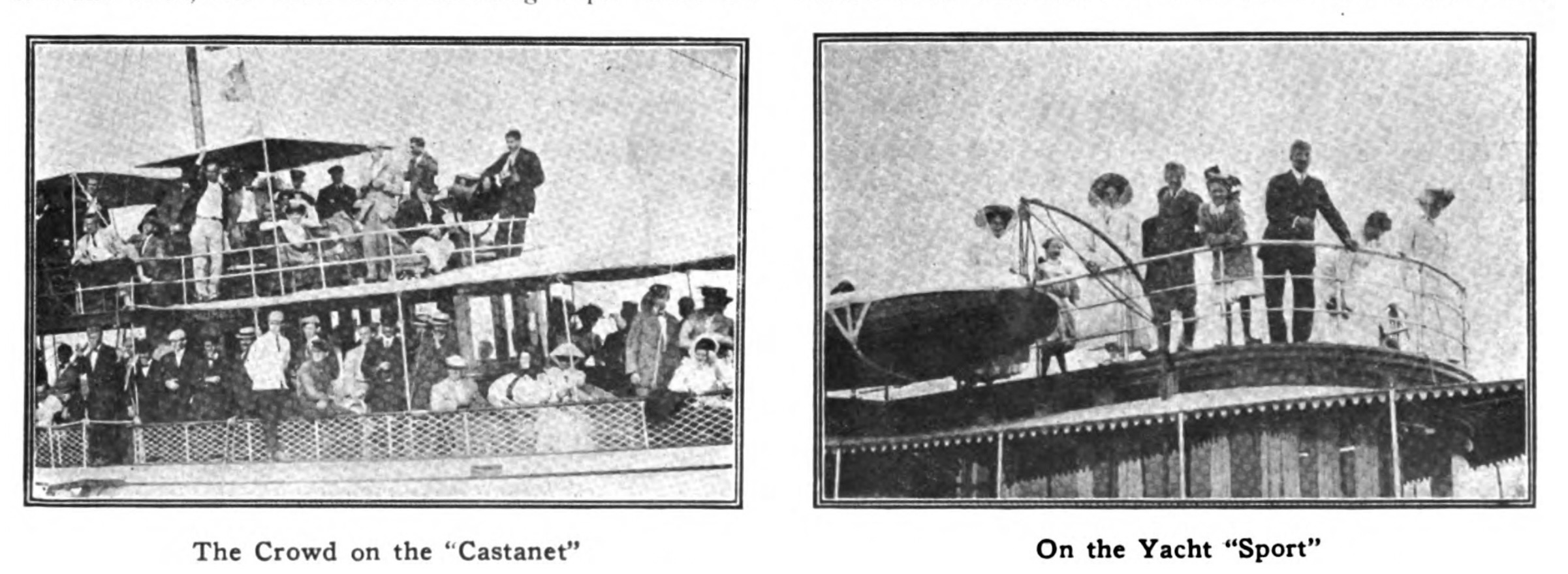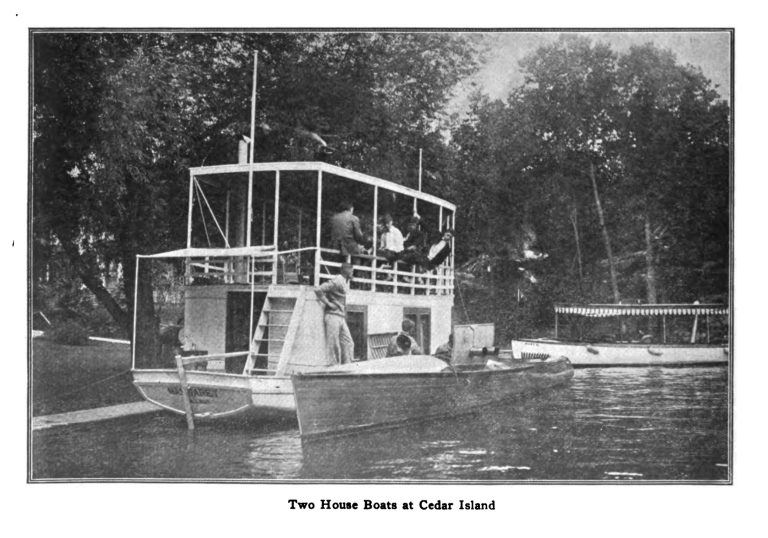Ezra Brockway, The Cedar Island House and the World’s Fastest Boat, Dixie II, All At Chippewa Bay
One of the lesser-known yet popular hotels in the 1000 Islands Gilded Age was the Cedar Island House located on Cedar Island in Chippewa Bay. Once located approximately nine miles downriver from Alexandria Bay and one-mile southeast of Singer Castle on Dark Island, the setting was ideal for those wishing to remove themselves from the hustle and bustle of the other areas on the river while still enjoying the prime fishing the waters had to offer and the Chippewa Bay Yacht Club, which hosted several Gold Challenge Cups, including the 1908 races which saw the world’s fastest boat, Dixie II, win.
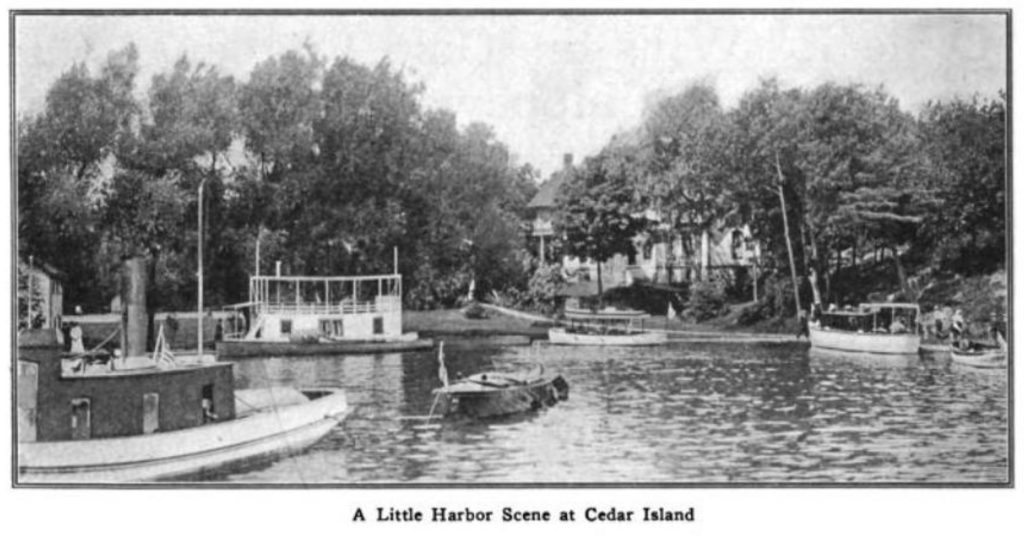
No history of the area would be complete without mentioning one of its earliest inhabitants, Ezra Brockway, who later signed his name “Sir Gorg William Recks Bonapart, King of the Universal World.” Ezra fought in the Windmill Fight of November 1838 near Prescott, in Upper Canada. Brockway lost a couple of fingers and suffered a cut to his face by a bullet in the battle of Tuesday of the five-day fight.
According to the Ogdensburg Journal article from his obituary printed March, 1876, he came to Ogdensburg from Canada during the Rebellion of 1837-38 and was always considered eccentric, “which increased with time, first carrying him to hermitage, and finally settling into monomania of spiritualism.”
Brockway was most notable for concocting his famous “Brockway Salve,” a cure-all that made him well known in the region. He settled on Cedar Island where he lived a simple live as a hermit, and grew increasingly eccentric and labeled a “moderate lunatic,” selling his salve with the following proclamation in 1875 “The Ezra Brockway Salve iss maid by The Same Persion, But the name iss Altered Tew Sir Gorg William Recks Bonapart.”

It is believed the Cedar Island House was built sometime after his death, though no definitive date of construction could be found. Its earliest mention in local newspapers came in July 25, 1888, from the Ogdensburg Journal, which wrote–
The Cedar Island House, at the entrance to Chippewa Bay, kept by Martin P. Phillips, has become one of the most popular river resorts. Mine host Phillips is a genial fellow, running his hotel for the accommodation of his guests, and working hard to make every one who visits him have a good time.
As regards table and accommodations, they are generous, neat and comfortable, at reasonable prices. Cedar Island contains about 36 acres, part of which is a garden, producing fruits and vegetables for the hotel and neighboring cottages, but the largest portion is a fine combination of hill and vale, stretches of grass and clumps of leafy foliage as one can find on the St. Lawrence.
The excellent fishing in the vicinity attracts large numbers of sportsmen and visitors from Alexandria Bay and remoter points.
The Guide and Island Wanderer both touch at the hotel dock on their daily trips. If you want to get the worth of your money and have some real enjoyment, Cedar Island is the place to visit.

By this time, Cedar Island had a number of cottages built upon it and the Cedar Island House was proving to be a popular spot under proprietor Phillips, who was originally from Oswego, N.Y. Like other small hotel-resorts, the Cedar Island House had a hired manager for the season, but was also available at times to be leased out to others to manage for the season, or leased to an entire party or family for the duration.
Tragedy nearly struck the Cedar Island House in November of 1887 when a fire broke out during a period of high winds. A child burning matches had set fire to one of the rooms where it smoldered for almost three hours, “burning through to the outside of the house on the windward side,” according to the Watertown Daily Times. The hotel would have been another loss to fire for the 1000 Islands region had it not been for several men working on a nearby cottage, who were able to contain the flames from spreading by cutting the area out with axes.
During the 1891 season, Phillips had an addition added to the Cedar Island House to keep up with the demand for rooms, nearly doubling its occupancy. The 50 foot long, 30 foot wide structure was two stories high and the largest of several smaller additions. The dock was also extended and enlarged to accommodate first-class steamers which meant the potential for more business.
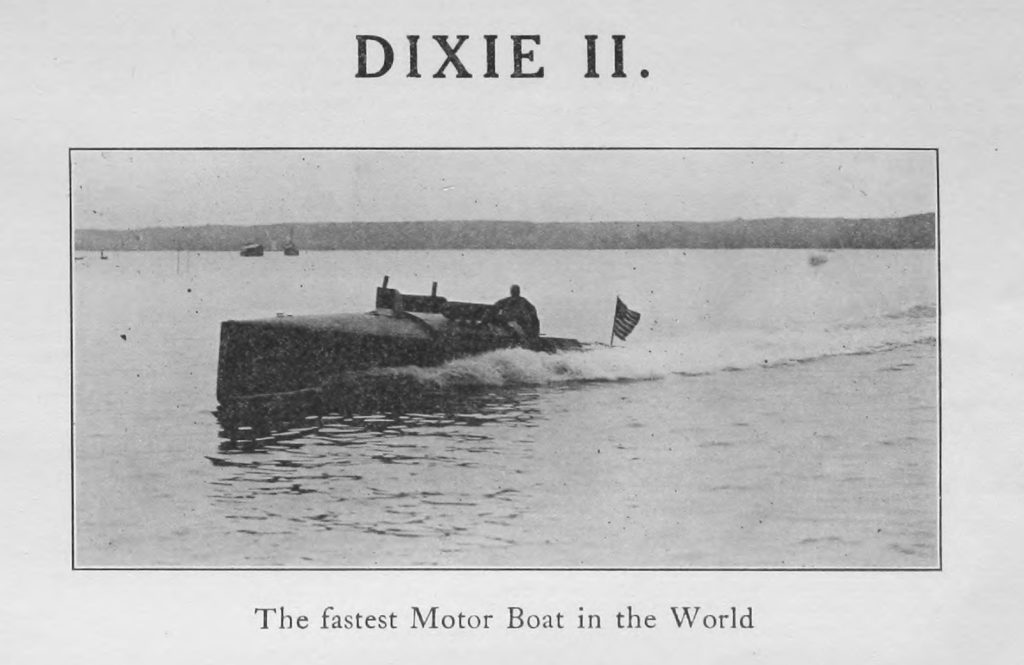
Dixie II, World’s Fastest Boat in 1908
In 1908, the Chippewa Yacht Club once again hosted the Gold Challenge Cup. After handily beating challenger Wolseley-Siddeley for the British International Motorboat Cup (the Harmsworth Cup) in Huntington Bay, Long Island, the successor to the prior year’s winner Dixie I, Dixie II had half as much horsepower than the Wolseley-Siddeley at 200 hp vs. 400 hp. Nevertheless, it beat out the competitors and would next race at the Gold Challenge Cup, held at the Chippewa Bay Yacht Club, as the fastest boat in the world.
Owned by ex-commodore E. F. Schroeder of the Motorboat Club of America and piloted by Captain S. Bartley Pearce, the duo responsible for Dixie I, Dixie II broke the record the following day after the International Cup win, which was held by the Wolseley-Siddeley, 34.96 statute miles an hour, by a time of 36.049 statute miles an hour. In addition to the owner and captain, the team also consisted of the Crane brothers, Clinton being Dixie II’s designer and Henry M. its engine’s designer. The boat would then ride to City Island, where it was built, just across the sound, and be worked on before heading to Chippewa Bay for the Gold Challenge Cup.

Below is a partial description of the race in Chippewa Bay witnessed by thousands, as reported in Yachting, October, 1908—
On August 20 the gun for the start of the first race was fired at three o’clock, and the “get-away” was undoubtedly the prettiest thing ever seen in motor-boat racing. The eight fliers shot over the line, with Dixie II holding the advantage. She never lost it. At the end of a half mile she had forged 200 yards in the lead. When the racers had gone half-way around the course they ran into a terrific rainstorm which somewhat quieted the surface of the river.
This was the first race in which Chip III had started, and it was the first view the public had been permitted to have of her. She created a terrible fuss in the water and did not take kindly to the high waves, which impeded her speed more than any of the other contestants. The exhausts were badly placed, for this weight, even though very slight, being high and on the extreme side, caused her to sway far more, than if they had been in the center of the boat. This race was won by Dixie II, whose time was 1 hour 1 minute and 38 seconds, or 19 seconds better than the time of Chip III.

The float upon which the judges and other officials were was anchored about 250 yards off Cedar Island, and from this the course lay up the river to a buoy south of Whiskey Island, back down the Canadian Channel to another buoy at the foot of Cedar Island, then back to the starting point. The boats went around this course twice, making it a total race of 30 miles.
Dixie II triumphed in the second race. Although only a few seconds ahead of Chip III in crossing the finish line it would have been easy for her to have won by about 10 minutes. But she really played with the other boats and on several occasions eased down to allow Chip to catch up and would then run away from the latter as if she was at anchor.
All the racers got away to a good start except U.S.A. and Stranger, both of which lagged a little, but before the boats had gone an eighth of a mile Dixie had assumes a commanding lead which she never let slip away. Owing to extremely rough water the start in this race was delayed until four o’clock, but nothing was gained by the wait.
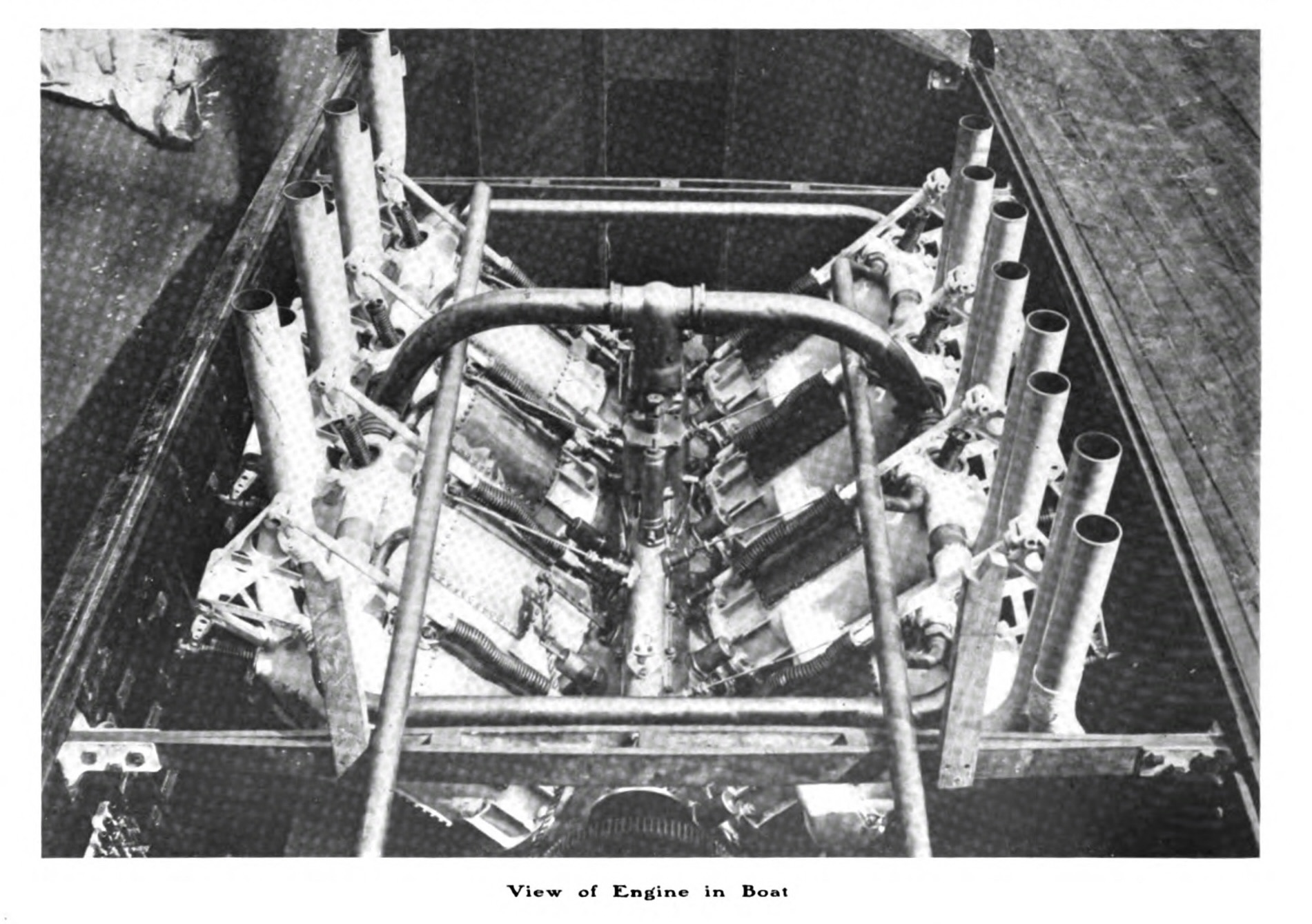
The second heat was noteworthy for two reasons. The first was that both Dixie and Chip covered the 30 miles in less than an hour; the second that Pirate took exactly the same time, even to a second, to cover the first half of the course on this day that she did on the first. On each occasion she required 33 minutes and 34 seconds to travel 15 miles.
On the last day Dixie won again amid a great tooting of whistles and other salutes, and so cinched the Gold challenge cup for the Thousand Islands Yacht Club, which she represented, and over whose course, near Alexandria Bay, the races will be held next year.

Cedar Island and the Cedar Island House became ground zero over the course of the three-day race, with hundreds of boats in the area. It couldn’t be determined when the Cedar Island House closed for good, but long-time proprietor Martin Phillips passed away in 1918 at the age of 74. A veteran of the Civil War, he died in the home of his sister-in-law, Catherine Lander, in Central Square, N.Y.
Cedar Island House, along with several other area cottages, were ransacked early the following year in February. The island, and house, apparently went into foreclosure the following year. An article in the March 15, 1920 Watertown Daily Times stated the property contained about 50 acres and was purchased by Martin P. Phillips from James Brockway in 1885. No other information could be found regarding what became of it afterward.
